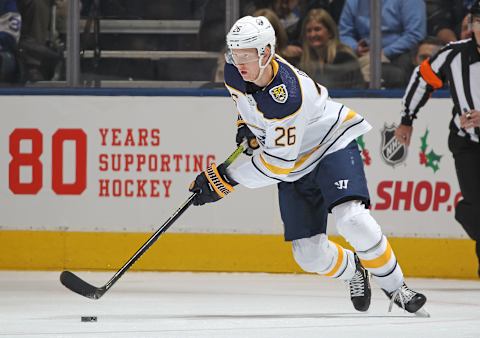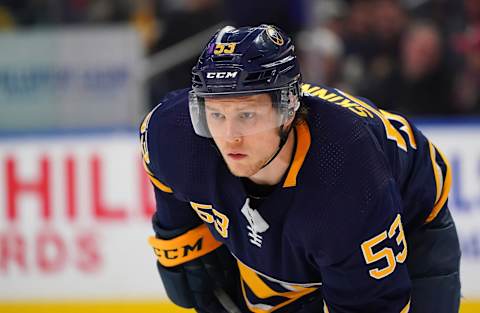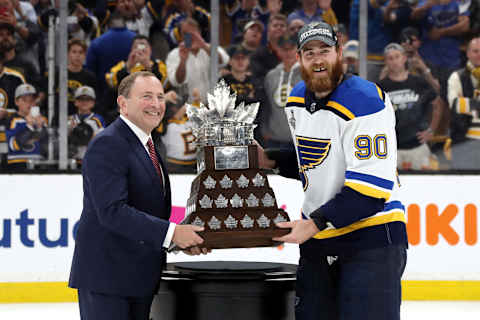Buffalo Sabres: Top 3 defining moves of Jason Botterill’s tenure as GM


Jason Botterill’s tenure with the Buffalo Sabres will ultimately be remembered by these moves.
Merely three weeks after getting a vote of confidence from the Pegulas, the Buffalo Sabres owners, former Sabres general manager Jason Botterill finds himself without a job. The Pegulas bought the Sabres in 2011 and now they have their fourth general manager with Kevyn Adams.
Botterill’s tenure with the Sabres started off with high hopes in 2017. He had just helped the Pittsburgh Penguins win back-to-back Stanley Cups under the tutelage of general manager Jim Rutherford. Botterill was highly thought of by many teams at the time, so it looked like a good hiring.
Unfortunately, it turns out he wasn’t ready to be a general manager. Though the Sabres improved slightly in point percentage in the last two seasons Botterill was with the Sabres, it simply wasn’t good enough for a team that demanded results.
General managers make good moves and bad moves. Botterill was no different. So let’s look at the moves that ultimately defined his tenure with the Sabres.
Honorable Mentions
Drafting Casey Mittelstadt in 2018 is something Botterill will be remembered for. He was drafted with the eighth overall pick. This wasn’t a good pick, as Mittelstadt has struggled in his first two seasons and even had to spend some time in the AHL during the 2019-20 season.
What makes it more painful is who was drafted after him. The list is pretty impressive and it includes Nick Suzuki of the Montreal Canadiens, Martin Necas of the Carolina Hurricanes, Owen Tippett of the Florida Panthers, and Erik Brannstrom of the Ottawa Senators.
It’s still too early to call Mittlestadt a bust, but the Sabres were clearly expecting him to contribute more by this point than just 39 points in 114 games.
There’s also the Wayne Simmonds trade at the 2020 trade deadline. It cemented the Sabres status as buyers, from some odd reason. Also, it showed how desperate Botterill was to make the playoffs. The fact that the Sabres didn’t make the playoffs despite an expanded postseason likely led to his departure.

3. Drafting Dahlin
Not everything about Botterill’s time with the Buffalo Sabres was poor. In 2018, the Sabres finally got some draft lottery luck, as they got the first overall pick. With that pick Botterill drafted defenseman Rasmus Dahlin, who was the consensus top pick.
Now, he’s probably not looking like that right now, but Dahlin should be a future building block for the Sabres blueline. He took some encouraging steps under head coach Ralph Kreuger after a rough start.
In his first two NHL seasons, Dahlin has picked up at least 40 points in each season, including 40 points in 59 games during the 2019-20 season. This came after an impressive rookie season, during which he had 44 points in 82 games.
Dahlin’s rookie season saw him get named as a Calder Trophy finalist, though he eventually lost out to Jordan Binnington of the St. Louis Blues and the eventual winner, Elias Pettersson of the Vancouver Canucks.
With how great Andrei Svechnikov is looking with the Carolina Hurricanes, it might be easy to be a little bit disappointed in Dahlin. But Botterill made a good move by drafting him, even if it was an extremely easy move. Unfortunately, Botterill botched his first-round pick in 2017. But he sure nailed it in 2018.

2. Trading And Signing Skinner
Remember when I said general managers make both good moves and bad moves? Well, sometimes they’re directly tied to each other! The duality of an NHL general manager was shown when Botterill traded for Jeff Skinner and then signed him to an ill-advised long-term deal.
The trade for Skinner was a very good trade. Botterill gave up virtually nothing of consequence for him – only a second-round pick in 2019 (which the Hurricanes used to draft goaltender Pyotr Kochetkov, prospect Cliff Pu, a 2020 third-round pick, and a 2020 sixth-round pick.
Skinner proceeded to have one of the most productive seasons of his NHL career. He formed immediate chemistry with center Jack Eichel and Skinner went on to tie his career-high in points with 63 and set a new career-high with 40 goals.
After the 2018-19 season, Skinner was set to become an unrestricted free agent. Not wanting to lose him for nothing, Botterill signed him to an eight-year deal worth $9 million annually. This made him one of the highest-paid forwards in the league.
Though the deal still has seven years left on it, Skinner certainly didn’t live up to it during the 2019-20 season. He had 23 points in 59 games. By comparison, Skinner had 23 assists during the 2018-19 season.
Botterill sort of had his hands tied with Skinner. Had he lost him for nothing after a career season, Botterill would have been seen as weak. One has to wonder why Skinner didn’t play with Eichel much during the 2019-20 season when so much of his success in 2018-19 came while playing with him. Maybe the relationship between Botterill and head coach Ralph Kreuger is another reason why the Sabres let him go.

1. The O’Reilly Trade
Jason Botterill will forever be remembered in Buffalo as the guy who traded Ryan O’Reilly for a weak return. After the 2017-18 season, O’Reilly was pissed off about losing and made some comments about losing his love for hockey. Instead of trying to work things out, Botterill sent him to the St. Louis Blues for a first-round pick (which they traded for Brandon Montour), a 2021 second-round pick, Tage Thompson, Patrik Berglund, and Vladimir Sobotka.
That might be a lot of quantity, but they didn’t get much quality. Combined, Montour, Thompson, Berglund, and Sobotka have 60 points through their first two seasons with the Sabres. Meanwhile, O’Reilly has 138 points in 153 regular season games in St. Louis. That doesn’t include the 2018-19 postseason, during which O’Reilly had 23 points in 26 games.
Trading O’Reilly never made sense, especially not for the weak return the Sabres got for him. What’s worse is what Botterill did to replace O’Reilly – absolutely nothing. He gave up his second best center and did nothing to replace him. Instead, Botterill pretty much handed the second-line center job to Casey Mittelstadt, who didn’t do well.
Next. Every Team's Greatest Player Of All-Time. dark
This trade sums up what Botterill did in Buffalo. He was terrible at asset management and the Sabres should have seen red flags the moment this trade was made. It was a bad trade then, and it is somehow even worse now.